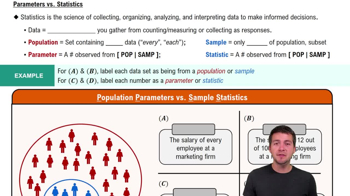You want to know the favorite spring break destination among 15,000 students at a university. Determine whether you would take a census or use a sampling. If you would use a sampling, determine which sampling technique you would use. Explain your reasoning.
Table of contents
- 1. Intro to Stats and Collecting Data1h 14m
- 2. Describing Data with Tables and Graphs1h 55m
- 3. Describing Data Numerically2h 5m
- 4. Probability2h 16m
- 5. Binomial Distribution & Discrete Random Variables3h 6m
- 6. Normal Distribution and Continuous Random Variables2h 11m
- 7. Sampling Distributions & Confidence Intervals: Mean3h 23m
- Sampling Distribution of the Sample Mean and Central Limit Theorem19m
- Distribution of Sample Mean - Excel23m
- Introduction to Confidence Intervals15m
- Confidence Intervals for Population Mean1h 18m
- Determining the Minimum Sample Size Required12m
- Finding Probabilities and T Critical Values - Excel28m
- Confidence Intervals for Population Means - Excel25m
- 8. Sampling Distributions & Confidence Intervals: Proportion1h 12m
- 9. Hypothesis Testing for One Sample3h 29m
- 10. Hypothesis Testing for Two Samples4h 50m
- Two Proportions1h 13m
- Two Proportions Hypothesis Test - Excel28m
- Two Means - Unknown, Unequal Variance1h 3m
- Two Means - Unknown Variances Hypothesis Test - Excel12m
- Two Means - Unknown, Equal Variance15m
- Two Means - Unknown, Equal Variances Hypothesis Test - Excel9m
- Two Means - Known Variance12m
- Two Means - Sigma Known Hypothesis Test - Excel21m
- Two Means - Matched Pairs (Dependent Samples)42m
- Matched Pairs Hypothesis Test - Excel12m
- 11. Correlation1h 6m
- 12. Regression1h 50m
- 13. Chi-Square Tests & Goodness of Fit1h 57m
- 14. ANOVA1h 57m
1. Intro to Stats and Collecting Data
Intro to Stats
Problem 1.T.2
Textbook Question
Determine whether each number describes a population parameter or a sample statistic. Explain.
In a recent year, the average evidence-based reading and writing score on the SAT was 528. (Source: College Board)
 Verified step by step guidance
Verified step by step guidance1
Understand the definitions: A population parameter is a numerical value that describes a characteristic of an entire population, while a sample statistic is a numerical value that describes a characteristic of a subset (sample) of the population.
Identify the context of the problem: The problem states that the average evidence-based reading and writing score on the SAT was 528 for a recent year. This value is based on all test-takers in that year, as it is provided by the College Board, which collects data for the entire population of SAT test-takers.
Determine whether the value represents a population parameter or a sample statistic: Since the value of 528 is based on the entire population of SAT test-takers for that year, it is a population parameter.
Explain the reasoning: A population parameter is used when the data represents the entire group being studied. In this case, the College Board has access to the scores of all SAT test-takers, so the average score of 528 is a parameter, not a statistic.
Conclude: The number 528 describes a population parameter because it summarizes a characteristic (average score) of the entire population of SAT test-takers for that year.
 Verified video answer for a similar problem:
Verified video answer for a similar problem:This video solution was recommended by our tutors as helpful for the problem above
Video duration:
1mPlay a video:
Was this helpful?
Key Concepts
Here are the essential concepts you must grasp in order to answer the question correctly.
Population Parameter
A population parameter is a numerical value that summarizes a characteristic of an entire population. It is a fixed value, often unknown, and is typically estimated through statistical methods. In the context of the SAT score, if the average score of 528 represents all test-takers in a given year, it is a population parameter.
Recommended video:
Guided course

Parameters vs. Statistics
Sample Statistic
A sample statistic is a numerical value that summarizes a characteristic of a sample, which is a subset of the population. Sample statistics are used to estimate population parameters and can vary from sample to sample. If the average SAT score of 528 was calculated from a smaller group of test-takers rather than all, it would be considered a sample statistic.
Recommended video:

Sampling Distribution of Sample Proportion
Descriptive Statistics
Descriptive statistics are methods for summarizing and organizing data to describe the main features of a dataset. This includes measures such as mean, median, mode, and standard deviation. The average SAT score of 528 is an example of descriptive statistics, as it provides a summary measure of the reading and writing scores for the population or sample in question.
Recommended video:
Guided course

Parameters vs. Statistics

 2:13m
2:13mWatch next
Master Introduction to Statistics Channel with a bite sized video explanation from Patrick
Start learningRelated Videos
Related Practice
Textbook Question
1
views
